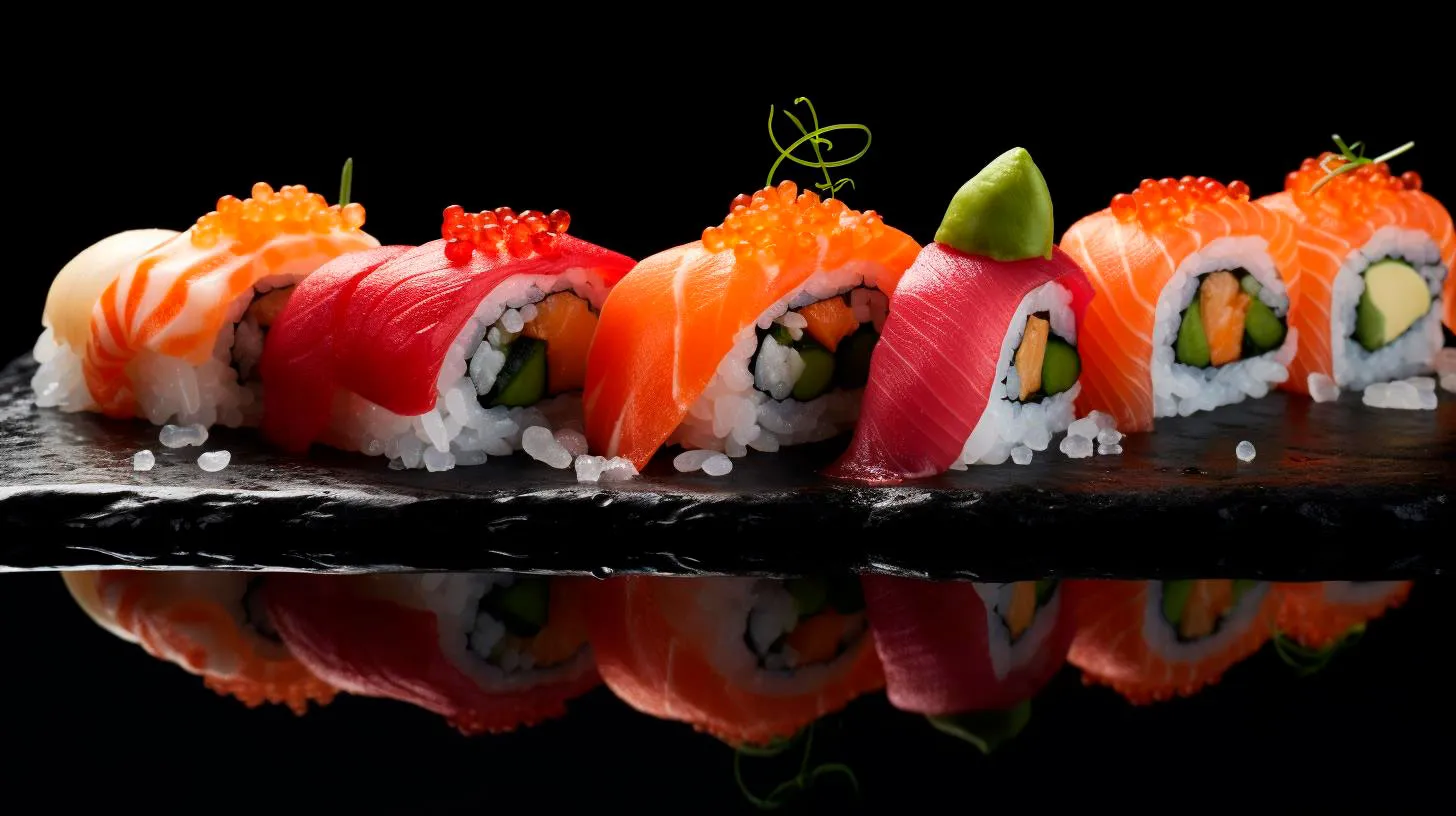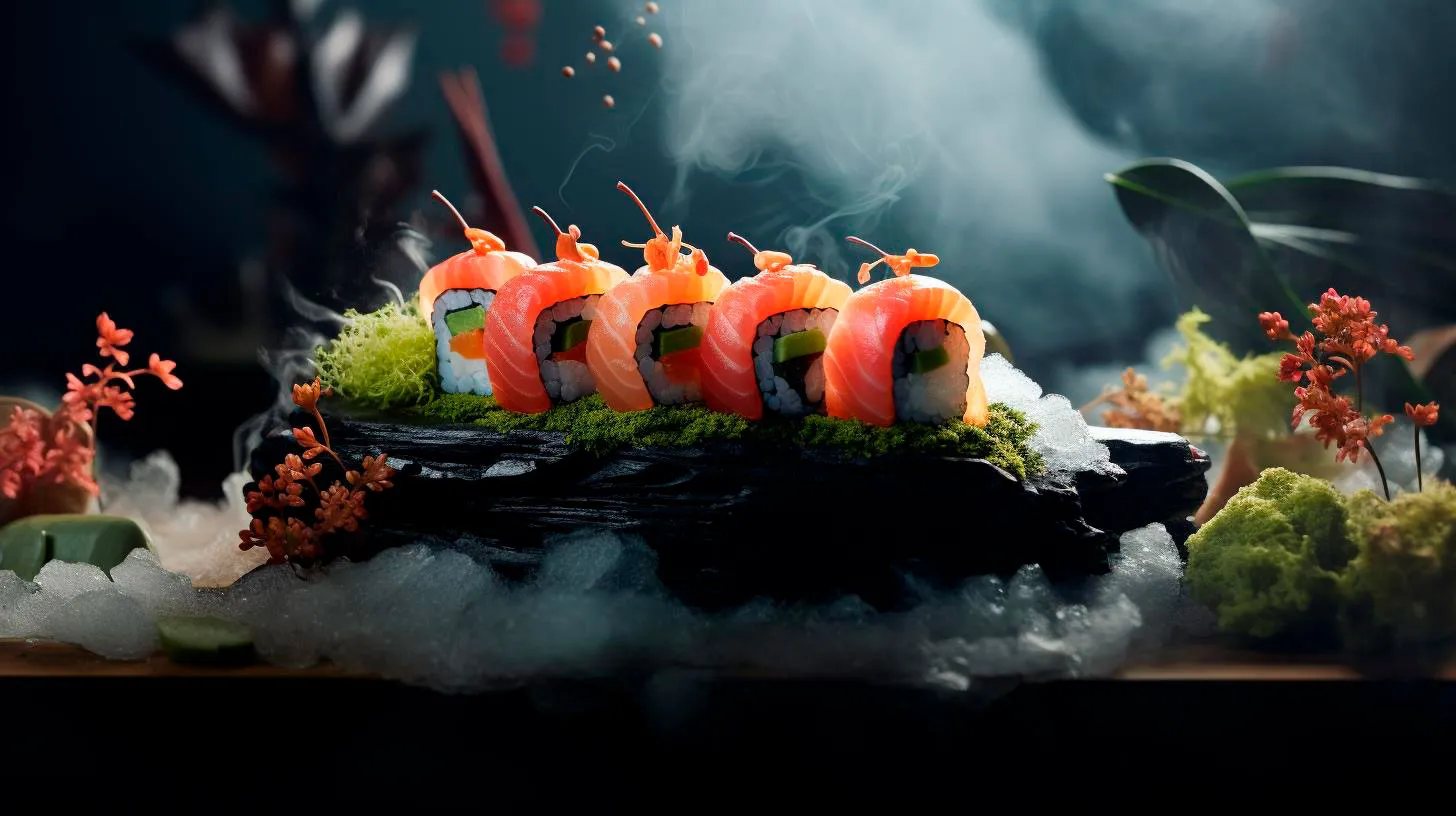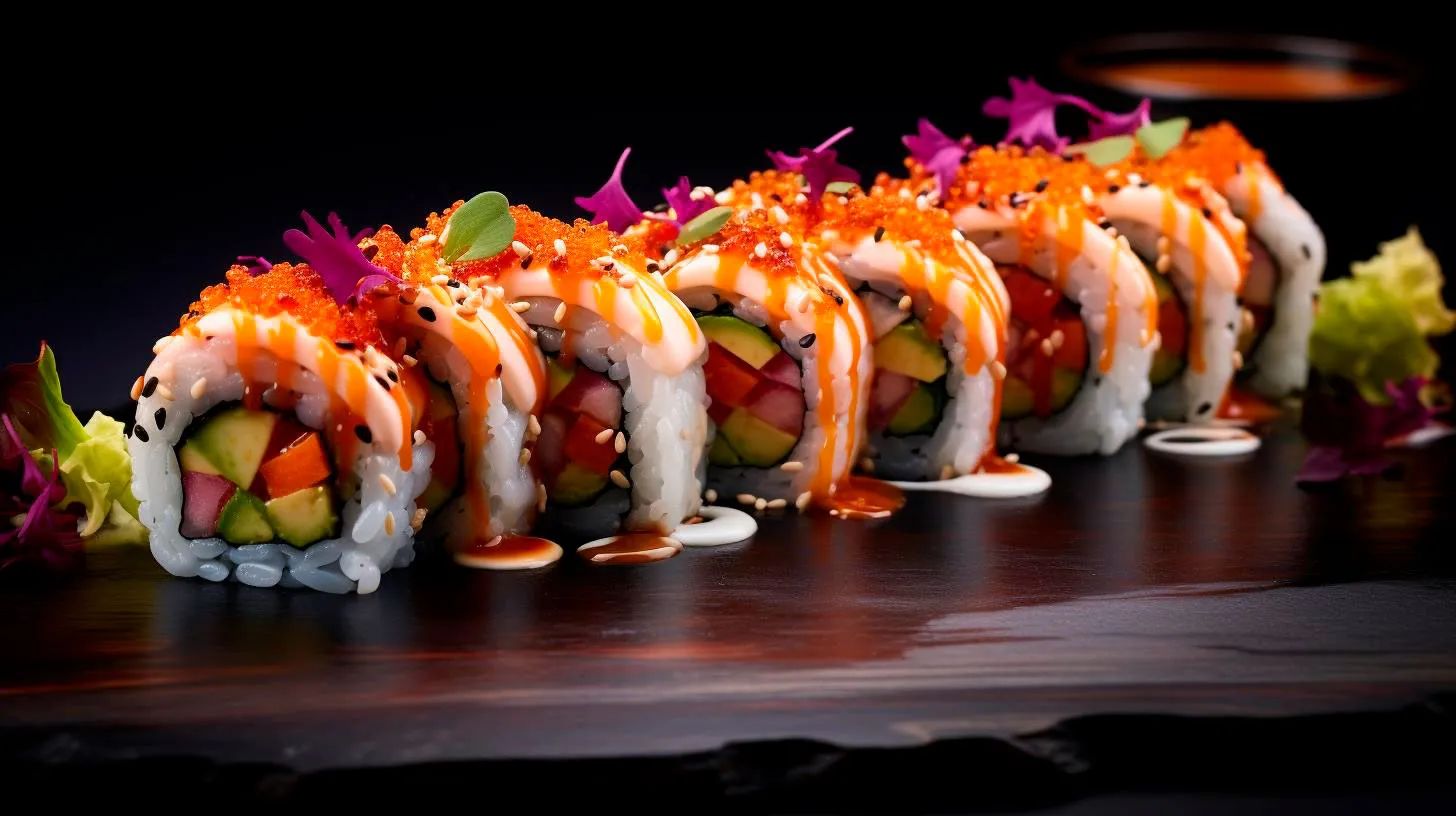Sushi Across Continents: Cultural Variations and Adaptations
In this article, we explore the diverse ways in which sushi has been embraced and transformed in different regions.
1. Sushi in Japan: Traditional Roots
In Japan, sushi is deeply rooted in ancient traditions and holds significant cultural value. Here are some key points to consider:
- Historically, sushi was a way of preserving raw fish by fermenting it with rice. Nowadays, this traditional technique is represented by sushi types like narezushi and funazushi, which focus on the fermentation process.
- The most widely recognized form of sushi is nigiri, consisting of a small mound of rice topped with fresh seafood or other ingredients.
- Other traditional options include maki (rolls) and chirashi (scattered sushi), both allowing for various toppings and fillings.
Japanese sushi masters dedicate years to perfecting the art of sushi-making, ensuring every piece is a masterpiece. Freshness, balance, and simplicity are the cornerstones of Japanese sushi, which makes it an exquisite culinary experience.
2. Americanizing Sushi: Fusion and Creativity
When sushi arrived in the United States, it underwent a transformation to suit local tastes and preferences. Americanized sushi embraces fusion and creativity, resulting in some unique adaptations:
- California Roll: In the 1960s, the California Roll was created to cater to Americans who were hesitant about consuming raw fish. This roll features avocado, cucumber, and crabstick, wrapped in seaweed and rice, with the rice on the outside.
- Spicy Tuna Roll: This popular variation combines spicy mayo-marinated tuna with sushi rice, cucumber, and sometimes scallions or avocado.
- Cream Cheese and Tempura: American sushi often incorporates cream cheese and tempura into rolls, adding a rich and crispy element.
American sushi enthusiasts appreciate flavors that push boundaries and welcome unique combinations, making sushi a versatile and ever-evolving culinary delight.
3. European Influence: Diversity and Modern Twists
Europe has also embraced sushi, introducing its own cultural twists and diverse interpretations:
- Scandinavian Influence: Nordic countries have incorporated local ingredients like smoked salmon, pickled herring, and dill into their sushi creations. This leads to refreshing flavor combinations.
- Fusion with French Cuisine: In France, sushi chefs combine Japanese techniques with classic French ingredients like foie gras, truffle, and caviar, resulting in luxurious and harmonious sushi options.
- Vegetarian and Vegan Options: Europe caters well to plant-based eaters, with a variety of vegetarian and vegan sushi options available, often featuring fresh local vegetables and alternative proteins like tofu or seitan.
European sushi reflects the region’s culinary diversity and showcases innovative fusions that tickle the taste buds of sushi lovers.
4. Sushi Goes Global: Popular in Unexpected Places
Sushi’s popularity extends far beyond its Asian and Western strongholds. Here are some examples of unsuspected regions where sushi has found a home:
- Brazil: Brazilians have embraced sushi wholeheartedly, blending Japanese flavors with their love for vibrant, colorful cuisine. They often incorporate local ingredients like mango, cream cheese, and even grilled meat into sushi rolls.
- Peru: In Peru, the fusion of Japanese and Peruvian cuisines has given rise to Nikkei cuisine, featuring sushi with a Peruvian twist. Nikkei sushi may include ingredients like avocado, chili peppers, and cilantro, resulting in exciting flavor profiles.
- Middle East: Sushi has gained a significant following in Middle Eastern countries, showcasing creative adaptations like the “Arabic Sushi Roll,” which uses hummus, falafel, and tahini in place of traditional ingredients.
Seeing sushi thrive in such diverse regions highlights its ability to adapt and appeal to varying palates and cultures.
In conclusion…
Sushi’s journey across continents has been nothing short of fascinating. From its traditional roots in Japan to innovative adaptations around the globe, sushi has evolved into a culinary phenomenon appreciated by people from all walks of life. Whether you prefer the simplicity of traditional nigiri or enjoy the creativity of fusion rolls, sushi offers a range of choices and flavors to suit every taste.
As sushi continues to transcend cultural boundaries, it remains a testament to the power of culinary exploration and adaptation. So, the next time you bite into a piece of sushi, take a moment to appreciate the cultural influences and unique flavors that have made it a global sensation.
Sustainable Sushi: Balancing Tradition and Environmental Impact
In this article, we will explore the concept of sustainable sushi and how it aims to strike a balance between the tradition of this delectable cuisine and its environmental impact.
The Environmental Challenge of Sushi
Sushi is primarily associated with fresh seafood, making it a high-demand product that heavily relies on our oceans’ resources. Unsustainable fishing practices, overfishing, and bycatch have all contributed to the decline of fish populations and the degradation of marine ecosystems. For sushi to have a future, it is crucial to tackle these environmental challenges head-on.
The Benefits of Sustainable Sushi
Embracing sustainable practices within the sushi industry not only helps protect our environment but also offers a range of benefits. Let’s explore some key advantages:
- Preservation of marine ecosystems: Sustainable sushi practices prioritize responsible fishing techniques, minimizing harm to marine ecosystems and preserving biodiversity.
- Support for local communities: By encouraging sustainable fishing practices and responsible sourcing, the sushi industry becomes an ally to local fishermen and coastal communities, ensuring their livelihoods.
- Consumer awareness: Educating sushi consumers about sustainable options raises awareness about the importance of choosing environmentally friendly seafood and encourages responsible consumption.
The Rise of Sustainable Sourcing
In recent years, the sushi industry has taken significant steps towards sustainability. Let’s explore some key initiatives:
1. Traceability and Certification Programs
Traceability is an essential aspect of establishing sustainable sourcing within the sushi industry. Certifications such as the Marine Stewardship Council (MSC) and Aquaculture Stewardship Council (ASC) ensure that seafood products meet specific sustainability criteria. By choosing sushi made from certified ingredients, consumers can enjoy their favorite delicacy guilt-free.
2. Alternative Ingredients and Farming Practices
With the decline of certain fish populations, sushi chefs are adopting creative approaches to diversify their offerings and promote sustainability. Some key practices include:
- Cultivating seaweed: Seaweed is an excellent alternative to fish-based sushi. It is highly sustainable, easy to grow, and rich in nutrients.
- Using responsibly sourced fish: Sushi establishments are increasingly mindful of their seafood sourcing, opting for fish species that are abundant and harvested sustainably.
- Supporting local aquaculture: Encouraging responsible aquaculture practices helps reduce pressure on wild fish stocks and maintain a steady supply of seafood.
An Educated Consumer is an Empowered Consumer
To truly make a difference, it is vital for consumers to be aware of the impact their sushi choices make. Here are some key takeaways:
- Choose sustainable sushi: Look for sushi establishments that prioritize sustainable sourcing, indicated by certifications or transparent sourcing information.
- Try alternative options: Embrace the opportunity to explore sushi creations that utilize alternative ingredients such as plant-based options and sustainably sourced seafood.
- Support local and responsible businesses: By patronizing sushi restaurants that actively promote sustainable practices, you contribute to the industry’s transformation towards a more environmentally friendly future.
As the demand for sushi continues to grow, the need for sustainability within this culinary art becomes increasingly important. By embracing sustainable practices, the sushi industry can ensure its longevity while preserving the oceans that provide us with such a delicious array of seafood. As consumers, let us make informed choices, supporting sustainable sushi that strikes the perfect balance between tradition and environmental impact.
Sushi Fusion: The Innovative Blend of Japanese Cuisine with Other Flavors
Sushi fusion is an exciting culinary trend that combines traditional Japanese sushi with flavors and ingredients from different cuisines, creating a unique and adventurous dining experience. By blending the best of Japanese cuisine with other culinary traditions, sushi fusion offers a delightful fusion of flavors that appeals to a wide range of palates.
The Art of Sushi Fusion
At its core, sushi fusion seeks to marry the traditional artistry and techniques of Japanese sushi with the bold flavors and ingredients of other cuisines. Whether it’s incorporating spices from Indian cuisine or infusing Latin American flavors into sushi rolls, sushi fusion chefs are constantly pushing the boundaries of creativity.
This innovative approach to sushi allows chefs to experiment with different ingredients, textures, and flavors while maintaining the essence of Japanese sushi. By combining ingredients such as avocados, mangoes, jalapenos, and even cream cheese, sushi fusion brings a new twist to the traditional delicacy.
Advantages of Sushi Fusion
Sushi fusion offers several advantages that make it a sought-after dining experience for food enthusiasts:
- Expanded flavor profiles: By incorporating flavors from various cuisines, sushi fusion opens up a whole new world of taste experiences.
- Appealing to diverse palates: Sushi fusion caters to a broader audience, attracting those who enjoy both traditional sushi and other global culinary traditions.
- Creative presentation: Sushi fusion allows chefs to present sushi in new and exciting ways, adding to the overall dining experience.
- Highlighting local ingredients: Sushi fusion often incorporates local ingredients, promoting sustainability and supporting local producers.
The Rise of Sushi Fusion
Sushi fusion has gained immense popularity in recent years, with numerous sushi fusion restaurants popping up in major cities worldwide. This culinary trend has captured the attention of food lovers, who are always searching for unique and exceptional dining experiences. According to a study by Research and Markets, the global sushi market is expected to reach a value of $22.4 billion by 2026, driven in part by the increasing demand for innovative sushi fusion.
Key Takeaways:
- Sushi fusion is an innovative culinary trend that blends traditional Japanese sushi with flavors and ingredients from other cuisines.
- Sushi fusion allows chefs to experiment with different ingredients, textures, and flavors while maintaining the essence of Japanese sushi.
- The advantages of sushi fusion include expanded flavor profiles, appealing to diverse palates, creative presentation, and highlighting local ingredients.
- The rise of sushi fusion has led to the emergence of numerous sushi fusion restaurants, capturing the attention of food enthusiasts worldwide.
- The global sushi market is projected to reach $22.4 billion by 2026, fueled by the increasing popularity of innovative sushi fusion.
With its innovative blend of Japanese cuisine and other flavors, sushi fusion offers an exciting and adventurous dining experience like no other. As the culinary world continues to evolve, sushi fusion showcases the boundless possibilities that arise when different culinary traditions come together. So why not embark on a gastronomic journey and indulge in the delightful fusion of flavors that sushi fusion has to offer?
The Origins and Evolution of Sushi
The Birth of Sushi
The history of sushi dates back to the 7th century in Southeast Asia, where it was developed as a method to preserve fish. The concept of preserving fish in fermented rice was introduced in Japan during the 8th century. Originally known as “narezushi,” sushi went through several transformations before becoming the sushi we know today.
- Fermentation: In its early stages, fish was salted and packed in rice to promote fermentation. This process allowed the fish to be preserved for several months.
- Preservation: As time passed, the Japanese realized that the rice served primarily as a means of preserving fish rather than being consumed along with it. They started discarding the rice and consuming only the fish, eventually giving rise to a sushi variant called “nigiri sushi.”
- Hand-Rolled Sushi: It wasn’t until the 17th century that the concept of rolling sushi with seaweed emerged. This innovation, known as “makizushi,” revolutionized the sushi industry by introducing a new way of presentation and combining flavors.
The Evolution of Sushi
Sushi has undergone significant changes throughout history. From its humble beginnings as a preservation method, it has evolved into an intricate culinary art form enjoyed by people of all cultures. Here are the key milestones that shaped sushi’s evolution:
Edo Period (1603-1868)
During the Edo period, sushi became increasingly popular as street food due to the growth of urban centers like Tokyo. With the advent of refrigeration, the fermentation process was no longer needed, and “Edomae sushi” emerged. This style focused on using fresh fish combined with vinegared rice, providing a more enjoyable and flavorful dining experience.
Modernization and Globalization
In the 20th century, sushi underwent a remarkable transformation. The introduction of refrigeration and improved transportation allowed fresh fish to be transported across long distances, making sushi accessible to a broader audience. Additionally, the development of sushi conveyor belts and sushi restaurants outside of Japan contributed to its globalization.
The Advantages of Sushi
Sushi has numerous advantages that have contributed to its popularity worldwide:
- Health Benefits: Sushi is generally considered a healthy food choice due to its low-calorie content and high nutritional value. It is an excellent source of omega-3 fatty acids, vitamins, and minerals.
- Customization: Sushi offers endless possibilities for customization. Whether you prefer vegetarian options, sashimi, or intricate rolls, there is something for everyone.
- Visual Appeal: The artistry displayed in sushi presentation makes it a feast for the eyes. The colorful ingredients, delicate arrangements, and elegant plating contribute to its visual appeal.
Key Takeaways
Sushi has come a long way from its humble origins as a preservation technique. Its evolution throughout history has shaped it into a revered culinary art form. Today, sushi brings people from various cultures together, offering a unique dining experience that combines taste, health benefits, and aesthetic pleasure.
So next time you savor a delicious piece of sushi, take a moment to appreciate the centuries of craftsmanship and innovation that went into creating this iconic dish.



